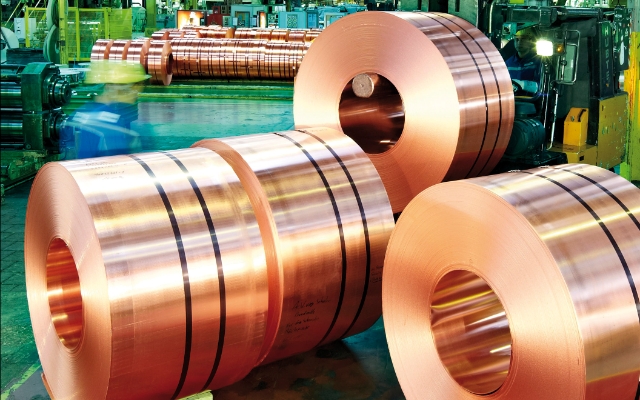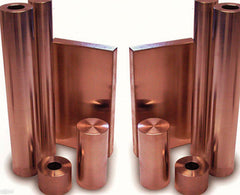Discover the Advantages of Using Top Notch Copper Products for Home and Industry
Discover the Advantages of Using Top Notch Copper Products for Home and Industry
Blog Article
Just How Copper Products Add To Sustainable Practices in Numerous Sectors
Copper products are progressively recognized for their significant contributions to lasting techniques across several industries, driven by their integral homes such as longevity, recyclability, and efficiency. In renewable resource systems, for instance, copper improves the functionality of solar and wind modern technologies, while its application in building and construction minimizes waste with longevity. Additionally, the product's antimicrobial qualities use encouraging benefits in medical care setups. As markets look for to take on even more lasting methods, the duty of copper can show essential in accomplishing environmental objectives. What implications might this have for future developments in sustainability?
Copper in Renewable Energy
Copper plays a crucial role in the development of renewable resource innovations, functioning as an important conductor in numerous applications. Its extraordinary electric conductivity and resistance to rust make it a suitable material for electrical wiring, which is necessary in photovoltaic panels, wind turbines, and energy storage systems. In solar photovoltaic or pv systems, copper is made use of in the interconnections and circuitry, allowing efficient power conversion from sunlight to electrical energy.
In wind energy, copper is important to the generators and transformers that transform kinetic power into electric energy, making certain optimum efficiency and reliability. Furthermore, the need for electrical cars (EVs) is boosting, with copper being a crucial part in batteries, motors, and billing framework. The shift to EVs significantly enhances the demand for copper, as these vehicles usually make use of 4 times a lot more copper than traditional inner combustion engine cars.
As the world seeks to reduce climate modification and shift to lasting energy sources, copper's role becomes increasingly critical. The product not just enhances the efficiency and sturdiness of sustainable power systems yet additionally supports the more comprehensive goal of lowering greenhouse gas emissions and promoting a sustainable future.
Eco-Friendly Construction Products
In the last few years, there has been a significant change towards the adoption of green building and construction materials in action to growing environmental worries. This adjustment is motivated by the requirement for lasting choices that reduce eco-friendly impacts while keeping structural stability and aesthetic appeal.
Copper, recognized for its sturdiness and recyclability, has become a crucial player in this industry. It can be utilized in roofing, plumbing, and electrical systems, adding to power performance and reducing waste. Copper's longevity suggests less substitutes over time, further improving its sustainability profile.
Furthermore, materials such as bamboo, recovered wood, and reused steel are obtaining popularity. These choices not just offer lowered environmental impact however also promote source conservation. As building codes increasingly highlight sustainability, building contractors and engineers are integrating these products right into their jobs, fostering development in design.
The raising adoption of green construction materials mirrors a more comprehensive dedication to sustainability in the constructed setting. By focusing on these materials, the building industry can dramatically lower its carbon impact, align with regulative requirements, and sustain a healthier ecosystem for future generations. This pattern marks a crucial step in the direction of a more sustainable future in building and construction.
Copper's Role in Healthcare
Recent research studies have highlighted the substantial duty of copper in healthcare setups, specifically due to its antimicrobial buildings. Copper surface areas have actually been revealed to reduce the visibility of virus, including bacteria and infections, by up to 99.9% within a brief period. This remarkable efficacy makes copper an invaluable material for high-touch surfaces in hospitals, such as doorknobs, bed rails, and IV posts, thus adding to boosted infection control procedures.
Along with its straight antimicrobial results, copper additionally plays a function in the broader context of hospital sustainability (Copper Products). By incorporating copper right into clinical devices and furnishings, healthcare centers can decrease the occurrence of healthcare-associated infections (HAIs), which not just improves client end results however also lowers the prices connected with prolonged healthcare facility remains and additional treatments
Furthermore, copper's toughness and recyclability straighten with sustainable techniques, permitting accountable resource management. As medical care systems progressively focus on both client security and environmental stewardship, the assimilation of copper items is becoming extra prevalent. This double benefit highlights copper's important payment to a much healthier, more secure, and look at this web-site a lot more sustainable medical care atmosphere.
Sustainability in Transportation

Additionally, copper's toughness and rust resistance contribute to the long life of transport infrastructure (Copper Products). In rail systems, for instance, copper elements boost the reliability and performance of signaling and power systems, important for decreasing delays and energy usage. Additionally, copper's function in renewable resource systems, such as solar and wind, sustains sustainable transport solutions by offering tidy energy for electrical transportation options
Investments in copper modern technology not only foster sustainability but also promote economic growth and task production in eco-friendly fields. As markets make every effort to fulfill strict ecological regulations, the application of copper items in transportation becomes a critical strategy in attaining sustainability goals and advertising a cleaner, much more efficient future.
Copper and Circular Economic Situation
As the world progressively accepts sustainability, the role of copper in the round economy ends up being ever much more substantial. Copper's innate homes-- such as its conductivity, recyclability, and toughness-- setting it as an essential product in a resource-efficient economic climate. The circular economic climate intends to decrease waste and make the most of source usage via recycling and reusing materials, and copper excels in this respect.
The steel can be recycled indefinitely without loss of top quality, making it a perfect candidate for lasting practices across various industries, including building and construction, electronic devices, and renewable resource. By recuperating and reprocessing copper from end-of-life items, industries can considerably lower the demand for virgin materials, thus decreasing ecological effects connected with mining and address handling.
In addition, the combination of copper right into round economic climate structures not just saves sources but likewise promotes advancement. Organizations that prioritize copper reusing add to a much more sustainable supply chain, enhancing their competition while lining up with regulative needs and customer choices for eco responsible items.
Verdict
To conclude, copper items substantially add to lasting practices throughout multiple fields. Their necessary duty in boosting renewable resource technologies, promoting environmentally friendly building and construction products, supporting infection control in healthcare, assisting in lasting transport, and symbolizing the concepts of a circular economic climate underscores the adaptability and importance of copper. By incorporating copper into numerous applications, industries can achieve greater performance, minimize environmental impact, and straighten with international sustainability objectives, eventually cultivating a more lasting future.

Copper's superb conductivity makes it a preferred product in electric automobile (EV) systems, enhancing power efficiency and performance. In addition, copper's duty in sustainable energy systems, such as solar and wind, supports lasting transport options by supplying clean power for electric transit choices.
Their vital role in enhancing sustainable power modern technologies, advertising environmentally friendly building and construction materials, sustaining infection control in health care, helping with sustainable transport, and embodying the principles of a round economy underscores the flexibility and value of copper.
Report this page